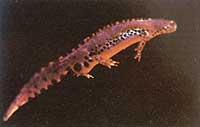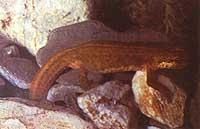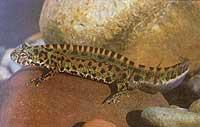Cormorants of the Basque Country

Discharges and other polluting elements that are deposited in lakes and rafts endanger the natural state of aquatic ecosystems, preventing the conservation of plant and animal species, including tritons.
The tritons (these amphibians of the superorder Urodela), which inhabit the water in the larval and in the reproduction, which is obligatory in the aquatic environment, are often called also aquatic lube and lizard. Tail long and pised laterally. This adaptation gives them some ease to swim. They are also active on earth, especially at night.
The triton diet is completely carnivorous. Any animal that can ingest can be considered prey. During its drought it feeds on worms, bazos, insects and other animals. Its prey in water, insects, aquatic oligoquets, fish eggs, tadpoles, etc. They are. They are often seen in the bottom of the water in search of dams that are detected through their movements and smell. Occasionally you can see cases of cannibalism. For example, the palmeated triton also devours its own larvae.
To find the tritons, any place where fresh water is stored is ideal: rafts, rafts, etc. They are found in streams of slow water, fluvial ponds and in the proximities of the cave and the marmolaire (triton marmolaire).
The reproduction begins in winter. For the palmate triton occurs between the end of November and June, and it begins later for the marbling triton and the triton of summits, in January.

At this time there are some variations of appearance and appearance. The fertilization is done by a spermatophore (sperm pack) that places the males after the bridal courtship, takes the females and keeps them in the cloaca. Later, the female will undertake the laying of eggs one by one to the aquatic plants by sea. Of these, at the end of summer, bright larvae will be created, which will become adult tritons.
In Euskal Herria we can find three species of tritons:
1. Tritús alpestris cyreni.
Females have a total length of 10-12 cm. The males are 9-10 cm. Its tail is as long or somewhat shorter as its head and body. The males, in heat, have along the back a small yellow goose and black spots; the dorsal and corporal color is bluish. The females, on the other hand, have a grey-olive colour. In both females and males, the orange belly side has black drops.
Lives only in areas of a certain height: From 600 to 1200 m in mountainous areas of the Cantabrian Range, from Asturias to the western Pyrenees. However, in the cantabrian marshes there are reliable references. In Euskal Herria is also located along the mountain line that goes towards the west. This species can remain in water throughout the year.
2. Cruus marmoratus.
It has a length of 16 cm and is the largest triton of our territory. It has green spots on the back and on both sides of the body and clear spots on the dark belly. The tail is so long or longer than the body of the head. Males have a very developed flame with green, black and white spots that lengthen in heat, back and tail. The females present on the back an orange yellow line.
Species present in the French state and in the Iberian Peninsula. In the Basque Country it extends from sea level to 1000 m. More abundant in the Mediterranean side, especially in Alava.
3. Tritús helveticus.

In our territory, males have a total length of up to 7 cm and females up to 8.5 cm. General brown color with irregular dark spots. The yellow belly, with few black spots, has a dark strip on both sides of the head. The tail varies depending on the sex: the male of this species presents a tail that ends compacted and that for its loss during the drought period, presents a terminal filament more evident in the zeal. However, the tail of the female is dotted and without filament. The horny male has a small dorsal bargain and in the posterior leg a dark membrane between the fingers.
Its characteristics are hydrophilic, so it is limited to the north of the Iberian Peninsula. It is the most abundant and best distributed triton species in the Basque Country, extending from sea level to 1300 m.
Although the general distribution area of the different species of tritons seems to be maintained, the biotopes of these amphibians are increasingly degraded and isolated from each other due to the poorly named advance. Therefore, we expect that the protective measures of these amphibians will be implemented as soon as possible.
Buletina
Bidali zure helbide elektronikoa eta jaso asteroko buletina zure sarrera-ontzian











